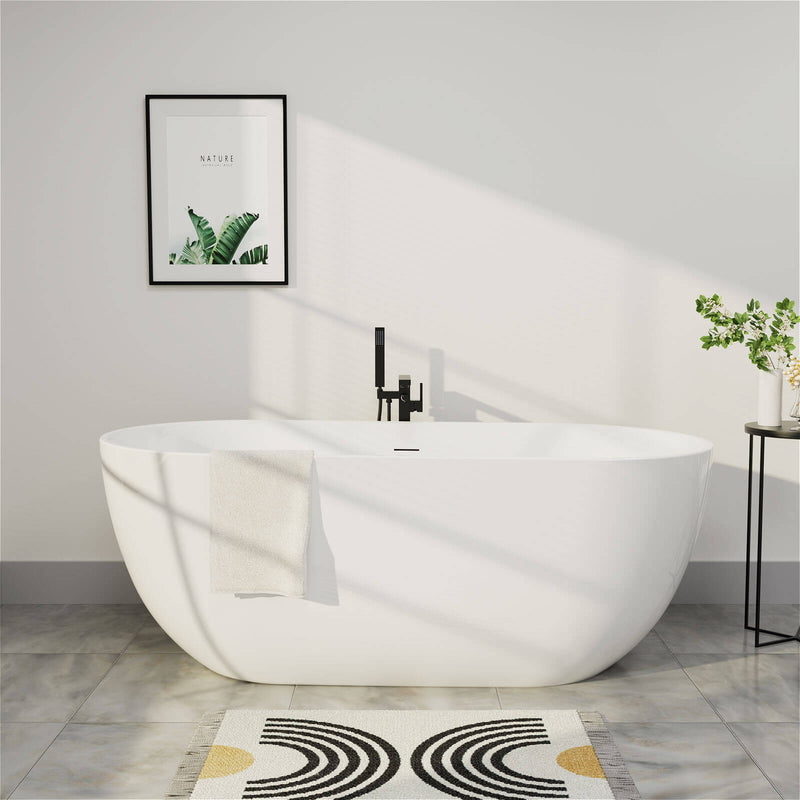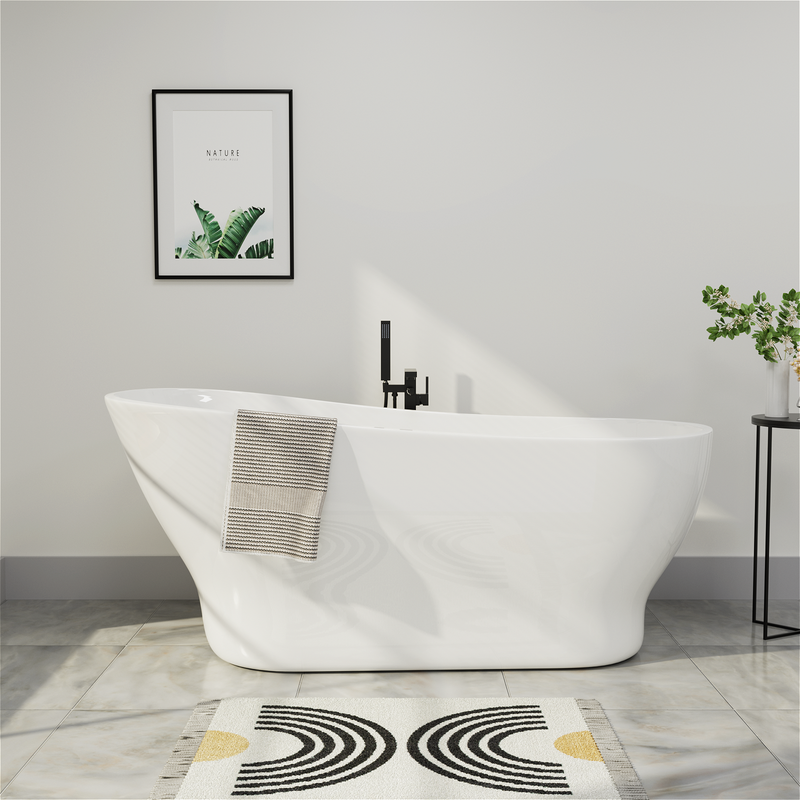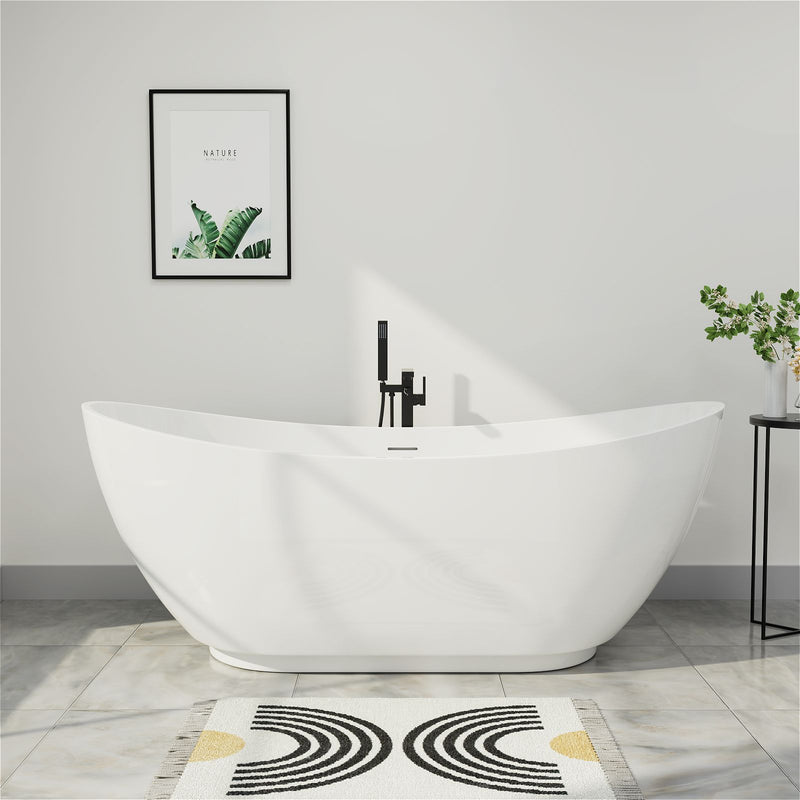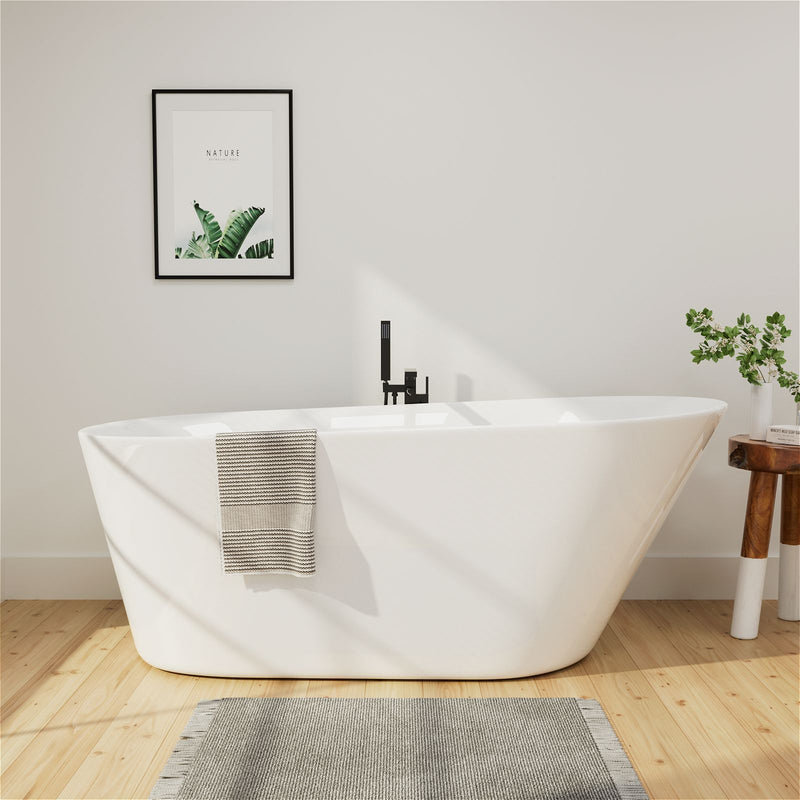In the planning of bathroom space, choosing a suitable slipper bathtub is not only about the daily bathing experience, but also an investment in the quality of life. This bathtub with a unique high-back design is becoming the first choice for more and more people who pursue a comfortable life with its excellent ergonomic performance and elegant appearance. However, facing the dazzling array of products on the market, choosing a slipper bathtub that is truly suitable for you requires comprehensive consideration from multiple dimensions.

Bathtub Material
Material selection is the primary consideration, which is directly related to the service life and daily maintenance of the bathtub. The traditional cast iron slipper bathtub is known for its excellent durability and thermal insulation performance. The enamel glaze layer covering the surface makes it easy to clean and not easy to scratch, but it is heavy, and special attention should be paid to the floor load-bearing during installation. Acrylic material is popular for its lighter weight and diverse design. High-quality acrylic bathtubs usually adopt a multi-layer structure with a glass fiber reinforcement layer in the middle to increase strength. The artificial stone material that has emerged in recent years combines the beauty of natural stone and the practicality of composite materials. It is not only warm to the touch, but also has excellent anti-fouling performance. It is a popular choice in the high-end market.
Bathtub Size and Bathroom Space
The matching degree of bathtub size and bathroom space is crucial. The length of a standard single slipper bathtub is usually between 150-180 cm and the width is about 70-90 cm, while the length of a double model can reach more than 200 cm. Before purchasing, it is necessary to accurately measure the actual available space in the bathroom, paying special attention to details such as door frame width and corner position to ensure that the bathtub can be smoothly entered and installed. For small apartments, a compact design with a length of 120-140 cm can be considered, and comfort can be ensured by optimizing the internal curve. At the same time, sufficient space for activities should be reserved. Generally speaking, at least 60 cm of activity area should be reserved around the bathtub to ensure convenience of use.

Ergonomic Design
Ergonomic design directly affects the comfort of use. The backrest angle of a high-quality slipper bathtub is usually designed between 105-110 degrees, which can provide good back support without causing neck pressure. The backrest height should be within the range of 50-70 cm to ensure that the head is properly supported. The internal curve of the bathtub should conform to the natural posture of the human body, especially the support of the waist and knees should be just right. In terms of depth, a water depth of more than 60 cm can achieve a truly immersive experience, but the height of the user should also be considered to ensure safe entry and exit.
Installation Method
The choice of installation method needs to be combined with the bathroom layout and personal preference. Freestanding installation can best show the aesthetic shape of the slipper bathtub and is suitable for bathrooms with larger areas; embedded installation is more space-saving and suitable for small apartments; corner installation can make full use of dead corners. No matter which method you choose, you must plan the location of the water supply and drainage pipelines in advance, especially for wall-mounted faucets that require pre-buried pipes, and the plan must be determined in the early stage of decoration.

Functional Needs
Functional needs are also an important consideration when purchasing. For users who pursue the ultimate relaxation experience, you can consider models with massage functions. The number and layout of spa nozzles directly affect the massage effect. In terms of thermal insulation performance, double-layer bathtubs usually have longer thermal insulation time than single-layer structures. Some high-end models are also equipped with intelligent control systems that can accurately adjust water temperature, control lighting, and even have automatic cleaning functions.
Maintenance
The convenience of maintenance is often overlooked, but it directly affects the long-term use experience. The smoothness of the surface determines the difficulty of cleaning, and the seamless one-piece design can effectively prevent dirt accumulation. The design of the drainage system is also worthy of attention. A high-quality drain valve should operate smoothly and seal well. For areas with hard water, choosing a bathtub made of anti-scale material can greatly reduce the workload of daily cleaning.
Style
The coordination between style and overall bathroom design cannot be ignored. The claw-foot design of the classical style is suitable for traditional decoration style, while the simple and smooth modern design complements the minimalist space. In terms of color selection, white is never out of date, while dark colors can create a unique sense of luxury. The matching of hardware accessories is also critical. The shape and material of the faucet should be consistent with the style of the bathtub.
Budget Planning
Budget planning needs to be rational and pragmatic. The price range of slipper bathtubs on the market is very large, ranging from a few hundred dollars to tens of thousands of dollars. When determining the budget, not only the purchase cost should be considered, but also the installation cost and long-term use cost should be calculated. Generally speaking, it is recommended to control the total budget of bathroom equipment between 15-20% of the total renovation budget, and bathtubs account for a large proportion of it.

Environmental Performance
Environmental performance is increasingly valued in modern home choices. Checking the environmental certification of the product, understanding whether the material contains harmful substances, and whether the production process meets environmental standards are responsible choices. Water saving is also a key consideration. Although slipper bathtubs usually have a large capacity, some new models can control water consumption while ensuring comfort through optimized design.
Special Needs
Special needs also require special attention. When there are elderly or children in the home, safety becomes the primary consideration, and anti-slip design, handrail configuration, etc. need to be carefully considered. For people with limited mobility, a low-height walk-in design can be considered. If there are pets at home, the scratch resistance of the material becomes particularly important.
Conclusion
Choosing a slipper bathtub is a process of balancing various factors. There is no absolute good or bad, only the difference between suitable and not suitable. Before making a decision, it is better to compare several products and communicate with professionals to ensure that the selected bathtub can perfectly fit personal needs and home environment, bringing real quality improvement to daily life. A suitable slipper bathtub is not only a piece of bathroom equipment, but also a comfortable companion that can accompany your family for many years. It is worth choosing carefully.
FAQs
Q: What are the key dimensions to check for a comfortable slipper bathtub?
A: Focus on the internal length, depth, and the bathing well. Ensure the tub is long enough to stretch out and deep enough for water to cover your shoulders when reclined. Also, consider the external footprint, including the rolled end, to ensure it fits your space.
Q: My bathroom is small. Can a slipper tub still work?
A: Yes, but opt for a compact model. Look for a slipper tub with a smaller footprint, perhaps a single-sloper design, and ensure you have clear access for installation and maintenance around the tub.
Q: What are the pros and cons of acrylic for a slipper tub?
A: Acrylic is popular because it's lightweight, retains heat well, and can be molded into the classic slipper shape. It's also warm to the touch. On the downside, it can be susceptible to scratches and may require more supportive framing than heavier materials despite its inherent strength.
Q: How can I assess the quality of a slipper tub's finish?
A: Examine the surface glossiness and smoothness. A high-quality finish should be glossy and feel smooth to the touch, with no visible waves or imperfections. Gently run your hand along the curves and interior to check for any rough spots.
Q: What are the plumbing considerations for a freestanding slipper tub?
A: Slipper tubs typically require a floor-mounted faucet or extended plumbing from the wall. Plan the placement of the tub, faucet, and drain carefully before installation, as these are often exposed and contribute to the overall aesthetic.
Q: Does the floor need to be perfectly level for installation?
A: Absolutely. A level floor is crucial for the stability of a freestanding slipper tub and for ensuring proper drainage from the tub. An unlevel installation can lead to standing water and an unstable tub.
Q: How do I clean and maintain the exterior of a slipper tub, especially behind it?
A: Since it's freestanding, you can access all sides. Use a soft cloth and a recommended cleaner for the tub's material. Its design allows you to move around it for thorough cleaning, but ensure you leave enough space during planning for this.
Q: Are slipper bathtubs safe for children or older adults?
A: The high sides can make entering and exiting challenging. It is highly recommended to add non-slip mats or appliques inside the tub and consider installing grab bars nearby for added safety and stability.
Q: Is a single-end or double-end slipper tub a better choice?
A: A single-end slipper tub (with one raised end) is typically placed against a wall and is space-efficient. A double-end slipper tub (with both ends raised) is a striking centerpiece and allows for reclining in either direction, ideal for a central placement.





